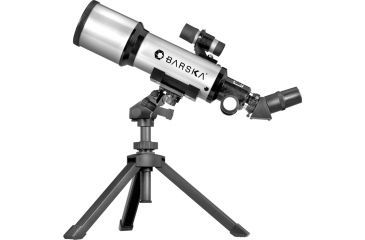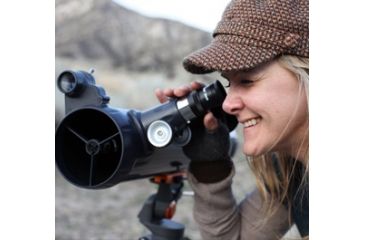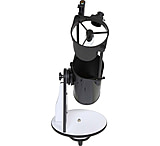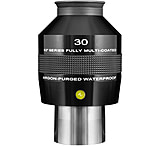There are many decisions to make when choosing a telescope. Even for an amateur telescope, there are two major decisions that need to be made right away. First, you should decide if you want a computerized or non-computerized telescope, as this affects everything from the price and difficulty to use to how you plan to use it. Next, you should determine how large of a telescope you want, and finally, whether or not you want a motorized telescope. This guide explores these questions and gives you the advantages of each option to help you figure out which telescope is perfect for your needs.![]()
First Question: Computer or No Computer?
The first decision to make when selecting a telescope is whether to buy a telescope with a computer or without a computer. Many modern telescopes have built-in computers that help you aim the device. Traditionally, you had to supply your own computer to work with a telescope, and there are still options that work this way.
Advantages of a Computerized Telescope
The sole duty of a telescope computer is to locate objects for you. This is important, however, since there countless potential objects to observe with even a small telescope. If you are a beginner, a computerized telescope locates many more celestial objects in a single night than you could find on your own. You do not have to be highly technical, since most telescope computers are user-friendly and relatively simple to operate. A computerized telescope is also highly recommended if you observe under badly light polluted skies. Navigating on your own with a star map is tough when you can't see many stars. Lastly, a computer on a telescope can make an excellent teacher for a motivated beginner. I know several excellent amateur astronomers who used the computer in just this way. A computer on a telescope does not have to be crutch or a way to avoid learning the basics of the night sky.
Disadvantages of a Computerized Telescope
Computers significantly add to the cost of a optical telescope. If on a budget, keep in mind that you will not be able to buy as large of a telescope if you opt for a computer. This is important because telescope size, not magnification, is what primarily determines performance. You should also ask yourself how well you do with computers. After all, a computer on a telescope is no different than any other computer. There can be software issues and headaches that can cut in to valuable observing time.
Perhaps the question to ask is, "Do I need a computer?" Learning to find objects on your own without a computer definitely takes longer and is more of a challenge, but many astronomers, me included, regard this as one of the more enjoyable aspects of astronomy. It isn't something to avoid, as you will need this skill to some extent if you stay with astronomy. Navigating with nothing more than a star map is tough under light-polluted skies but it is a very good option from a dark or only mildly light-polluted site. No computer also means you can buy a larger astronomy telescope to take advantage of the dark skies.
I'll Take a Computer
If you decide to go with a computerized telescope, you need a bit more information. There are two types of computerized telescopes - motorized (GOTO) and non-motorized. By the way, you do not have to supply your own computer on a computerized telescope. The computers are built into the telescope mounts and comes complete and ready to use.
Big Telescope or Small Telescope?
The second decision to make when selecting a telescope is telescope size. Size is measured in terms of the diameter of the lens or mirror. Telescopes are rated by their size, not their magnification. Telescope size, not magnification, is the primary factor in performance. It's not a difference in the type of object that you can see - a small telescope can see exactly the same types of objects as a large telescope. The difference is that a large telescope can see fainter objects and therefore many more of the same objects than a small telescope. A large telescope also reveals more detail than a small telescope and can handle higher magnifications better than a small telescope.
What Are the Differences Between Large & Small Telescopes?
Large telescopes are heavier and more time consuming to set up, which means they aren't as easy to transport and move as smaller telescopes. If you are in a light polluted area, it is often a better strategy to buy a more portable telescope and then transport it to a dark sky site than to invest in a large telescope and keep it at home. A small or medium size telescope under a dark sky often outperforms a large telescope under a badly light polluted sky. The best policy is not to simply buy the largest telescope you can afford, but to buy the largest telescope you can afford that has the size best suited to your observing site and style. In the end, the telescope you use the most is the best size telescope for you.
After deciding on computer or no computer and then telescope size, you can move on to other features including telescope design, type of telescope mount, and telescope eyepieces. For a through discussion of these other basics, be sure to review our How to Choose and Buy a Telescope guide for good info on what all the numbers mean.
Motorized or Non-Motorized?
GOTO(Motorized) Computerized Telescope
A GOTO computerized telescope is the most popular and best known computerized telescope. A GOTO computerized telescope has a computer and motors in the mount. You select the object you wish to see via a hand control on the computer, similar to the remote on a TV. The computer then moves the telescope into position via motors in the mount. These motors work with the computer to automatically keep the object in the eyepiece for as long as you wish to observe it. Meade and Celestron computerized telescopes are the best known and the Celestron Nexstar SE is a great example of state-of-the-art portable computerized telescopes. These smaller scopes use the same computer as the larger Meade and Celestron computerized telescopes.
Non-motorized Computer Telescope
A non-motorized computerized telescope has a computer built into the mount just as with a GOTO telescope, but there are no motors. This means you need to move the telescope by hand to the object you wish to see, and the computer guides the way. This type of computerized telescope goes by several names - manual computerized telescope, "push to" computerized telescope, and so on. Since there are no motors, there is also no automatic tracking, but the important thing is the computer. The good news is that no motors also mean a lower price, making this a great option for those who want a computer but are on a limited budget.














